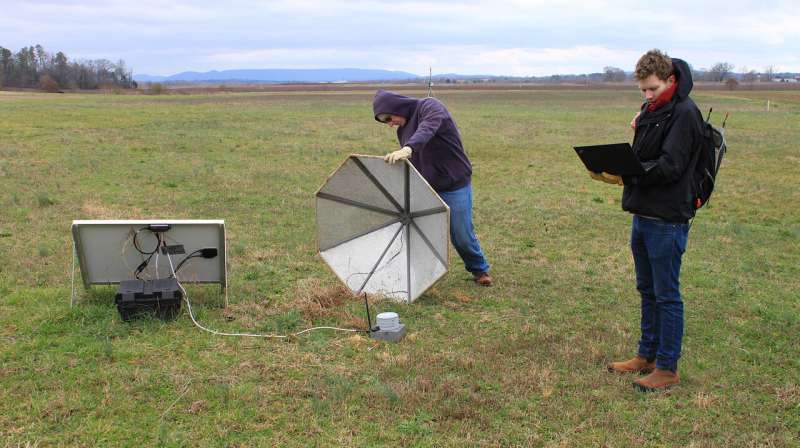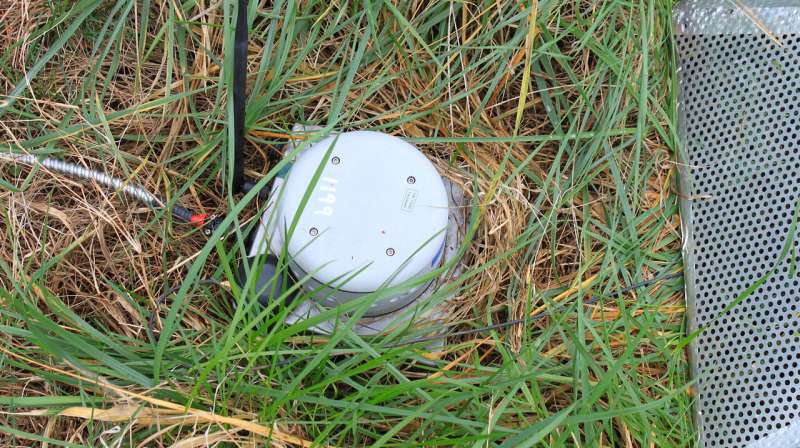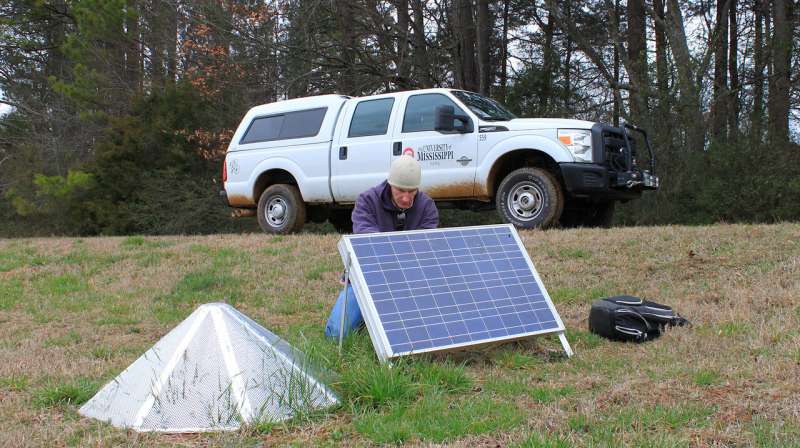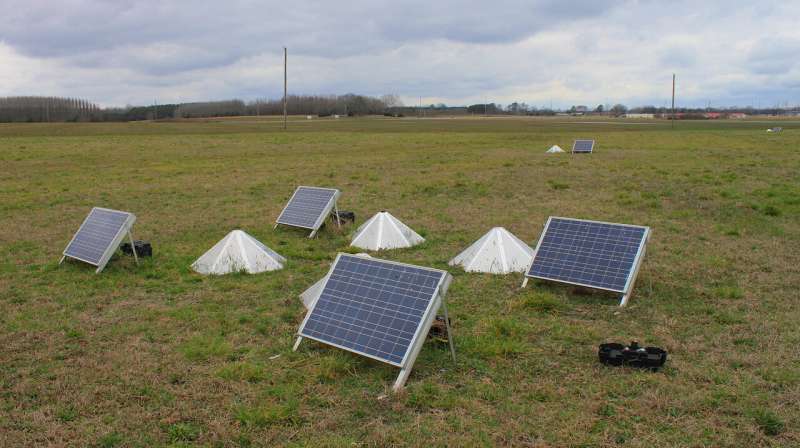Researchers working to detect, track tornadoes

The cold whipping across an Alabama field on this winter morning slaps away the warmth, slowly forcing fingers and toes numb.
Under a dull, overcast sky, University of Mississippi researchers trek across a damp pasture just north of Huntsville, braving the freeze and checking an array of 12 sensors that scientists at the UM National Center for Physical Acoustics are using in their research into tornado detection and tracking.
Each sensor consists of a 12-volt marine battery, solar panel, domed windscreen, necessary cabling and a UM-designed device that records infrasonic signals, or infrasound—acoustic signals at frequencies below what humans can hear. It has been known for some time that tornadoes generate these low-frequency sounds, although the exact mechanism for this production is not understood.
But UM researchers are hoping that by "hearing" tornadoes through infrasound, they might develop technology to revolutionize the detection and tracking of tornadoes, and greatly improve tornado warning methods.
"Radar does not detect tornadoes," said Roger Waxler, a principal scientist at the National Center for Physical Acoustics, or NCPA, and research associate professor of physics and astronomy at UM. "The wavelengths are too long, and they are upward-looking. Tornadoes are currently detected by sight. The weather services use spotters (people). The radar shows the large scale rotation in storms that can spawn tornadoes but don't always do so.
"These particular arrays are being deployed specifically for research into tornado detection and tracking. The geometry of the arrays is tuned to the signals emitted by tornadoes."
Even with the evolution in meteorological technology, detecting and tracking tornadoes is a nearly impossible task. But while tornadoes unpredictably swoop from darkening clouds, the violent storms leave a distinct mark and lasting damage as they barrel across a landscape.
Nationwide, more than 24,400 tornadoes have been reported since 2000, according to the National Centers for Environmental Information. Those tornadoes have killed almost 1,500 people and resulted in billions of dollars in damage.
On Easter Sunday (April 12) and into the early morning of Monday, a series of vicious tornadoes once again pummeled parts of the country, killing about 20 people in the South, including at least 11 in Mississippi, and destroying countless homes and buildings.
Mississippi has been welted by more than 2,700 tornadoes since Jan. 1, 1950, according to the Storm Events Database, which is maintained by the National Oceanic and Atmospheric Administration, or NOAA. These tornadoes, an average of almost 39 a year, have resulted in about 500 fatalities, more than 6,750 injuries and some $2.8 billion in property damage.
"The tornado infrasound research happening at NCPA has the potential for a significant impact in our region and across the nation," said Josh Gladden, UM vice chancellor for research and sponsored programs. "Most importantly, it has the potential to augment and improve early warning systems in our communities, which could save lives.
"A further significant impact, however, is the potential to obtain much more tracking data for tornados than scientists currently have. This should lead to an improved understanding of what conditions specifically trigger tornados and what paths they follow."

Infrasound on the ground
The infrasound group at NCPA, led by Waxler, first started examining the use of infrasound, which is typically generated by tornadoes, hurricanes, atmosphere-ocean interactions and explosions, two decades ago as a means of detecting clandestine nuclear weapons tests.
Since then, the work has expanded into other realms, including monitoring the intensity of hurricanes along the Atlantic seaboard, forensics of explosive events, probing winds in the upper atmosphere and the tornado research, which started in 2011 with arrays deployed in Oklahoma.
The current tornado detection and tracking research, titled "Infrasound Detection of Tornadoes," started in 2017 and is funded by NOAA through award Nos. NA17OAR4590168 and NA18OAR4590305.
Joining Waxler in the project is Garth Frazier, a senior research scientist at NCPA and UM research associate professor of electrical engineering, and Carrick Talmadge, also a senior research scientist at NCPA and research associate professor of communication sciences and disorders.
"Over the past two to three years, we have been able to consistently demonstrate the ability to detect and accurately track tornadoes that have occurred in northern Alabama with sensor arrays that are as far away as (62 miles)," Frazier said.
"We are still trying to gather sufficient data to increase understanding of what causes the sound to be generated and how to ensure that what we are hearing is caused by a tornado and not just a phenomenon related to thunderstorms. However, we are confident that the sound we have been detecting and tracking is not thunder."
The trio is supported in this research by several Ole Miss staff members, as the work of exploring how to detect and track tornadoes is much more than just plopping an array in a field and waiting to collect data. Hard work is involved, along with a lot of driving.
That's why on a freezing Friday in February, Hank Buchanan and Brian Carpenter, two research and development engineers at NCPA, are bundled against a cutting wind as they walk across a pasture at Alabama A&M University's Winifred Thomas Agricultural Research Station.
The 12 sensors of this array, planted next to a droning, busy highway on a slice of the station's 972 acres in Hazel Green, are just one array of seven that have been deployed this season in a line roughly slicing from northern Louisiana to northern Alabama.
Generally, eight to 10 arrays are deployed each season, with locations sometimes stretching to the northwest corner of Georgia or being closer to home, such as at the UM Field Station, northeast of the Ole Miss campus in Lafayette County. Each array usually consists of about eight sensors.
Choosing an exact array location is tricky, Buchanan said. Undesirable locations include areas that might flood—water plus electronics equals dead sensors. Fairly open areas provide the needed sunlight to power the sensors, but sometimes curious critters, such as field mice, chew through the wiring. Theft of equipment is pretty rare, and it's usually just a battery.

Sometimes an array location is simply about where the researchers can get permission to install it, which can be a hurdle when it comes to private land. The arrays are unobtrusive but need upkeep, so that means good access and sometimes moving arrays from prime hunting locations.
"From year to year, we may use the same sites if the landowner is willing and there are no issues with a particular site," Buchanan said. "The general idea is to position the arrays in a way that maximizes our chances of at least one array being in close enough proximity to capture acoustic data from a tornado if one should occur somewhere in the region.
"It's also beneficial to have more than one array get data on the same event. That standard, along with the general tendency for storms to move in a west-to-east direction in our region, left us with a line stretching from west to east across northern Alabama as our preferred area to deploy the arrays."
Collecting the data
Data from the arrays is collected about every six to eight weeks, which also provides a time for needed repairs. Usually, that means Buchanan and another NCPA staff member or researcher driving through the fields and hardwood forests of the Tennessee River Valley. On this first Friday, Carpenter accompanies Buchanan.
The pair park the acoustics center's Ford F-250 on a dirt road off U.S. 431 and get to work at the agricultural research station. On their checklist is downloading data from two recent tornadic events in the area, and the 12 sensors need checking.
From one of the first battery housings, Carpenter shakes out a mouse that had burrowed in the box to fend off the cold. Some of the sensors have dead batteries, so gloves come off and the intricate work of disconnecting and reconnecting wires is completed before fingers grow stiff from the frigid air.
After an hour-and-a-half in the elements, the work is completed. A quick Mexican lunch is consumed—Buchanan and Carpenter believe one of the perks of this work and the long drives is eating at different restaurants during their travels.
About 60 miles back toward Mississippi and the warmth of home, the pair check another array between Hillsboro and Moulton on a knot of a knoll down a muddy, red clay road close to the Old Time Gospel Fellowship church.
These arrays are problematic during summer because they are usually overgrown with kudzu, but winter has browned the kudzu and stopped its growth. In spring and summer, vegetation leafing out means more frequent checks.
"What was once an area with abundant sunshine can be completely covered in shade in a matter of a few days that time of year," Carpenter said. "The batteries we use will last about 10 days at most with no sunlight reaching the solar panels.
"When functioning properly and receiving an ideal six hours of good sunlight a day, the power system will run indefinitely if unperturbed."

While no animals are chewing through wiring on this lonesome Alabama hill, the domes protecting the sensors from the harshest elements also provide convenient and somewhat dry areas for fire ants. One sensor is immersed in a fire ant bed, but the stinging pests have abandoned this mound for an unknown, presumably warmer, spot.
Downloading the data from the individual sensors means finding Wi-Fi, even in the middle of seemingly nowhere. The specially created sensors are designed to accurately record infrasonic signals and log them at 1,000 samples per second. An accurate time reference is provided by GPS.
The raw data of the sensors is nothing more than a squiggly line, but that line is rich in information.
"Once the data is transferred to a computer, it can be processed using custom algorithms that detect when and where the tornadoes are located," Frazier said. "In the future, should the technology prove viable, this process can be fully automated to provide real-time information."
Every battery on this hill needs replacing, but the day has warmed; the work goes quickly, and soon the duo is headed west on their 160-mile way back to Oxford.
What comes next
The tornado detection and tracking work from the Ole Miss researchers has led to papers in such publications as The Journal of the Acoustical Society of America, and several speaking appearances, including earlier this year at the 100th meeting of the American Meteorological Society in Boston.
The work also has appeared in national news outlets, such as The Washington Post. And the researchers have made appearances on the WeatherBrains podcast and The Weather Channel to talk about the study.
More work needs to be done, though. More investigating. More data. But initial results are promising.
"We have demonstrated that detecting and tracking of tornadoes using their infrasound emissions is feasible," Waxler said. "We are currently investigating the physical mechanism through which the infrasound is emitted from a tornado, and we are analyzing data from nontornadic storms to see if there are any infrasound signals that might produce false positives.
"I believe that with continued funding, this research would result in operational warning systems within about five years."
Meanwhile, the dozens of sensors set out by UM researchers sit under white domes. In fields in Louisiana or on hillsides in Alabama, the arrays silently collect data that could save lives in the future.
Provided by University of Mississippi
















